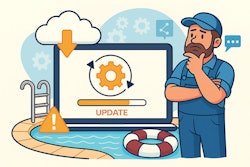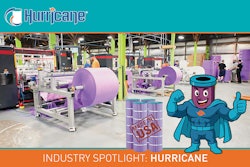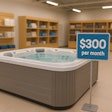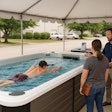Back in August, the North Texas chapter of the APSP got a phone call. It happened in the days following the “Usher incident,” in which the 5-year-old son of the famous R&B singer nearly drowned in a pool drain accident. The reporter in question was from a Dallas/Fort Worth-area TV station, trying to find a knowledgeable pool professional to talk to for a story about pool drain safety.
That led to Tom Sheehy, owner of Crystal Clear Custom Pools in Waxahachie, Texas. In just a few hours, he was filmed for the segment that aired that night. (Watch the clip below.)
For small business owners, media coverage is (usually) more than welcome. Being interviewed for a story gets your name out there, of course, but it also presents you as an expert in the field, boosting your credibility and making it easier for customers to trust you. Not to mention that any coverage for a pool and spa business improves the image of the industry as a whole.
However, you can’t just wait around for a reporter to call — you have to lure them with the right story. Here’s just a few tips to help.
Be confident
“Everybody’s going to be timid and have a ‘Why would they want to talk to me?’ attitude, but in reality, these reporters were dying to hear from anyone,” Sheehy says of his experience with the Usher story.
It’s true. As media companies across the country face layoffs and closures, editorial teams are stretched thin — meaning reporters rely on the pitches in their inboxes more than ever before. But you can’t go blindly emailing reporters, asking to be featured on the newscast or in a magazine, which brings us to the next point:
Develop a Pitch
Sheehy’s most recent turn media spotlight was prompted by an incident that gained national attention. While it’s rare that the pool and spa industry finds itself in the national spotlight, it’s likely you have events at your own dealership you can pitch to reporters.
Sheehy, for example, is working on a project called “Dive to Recovery,” in which a wounded veteran will receive his or her own swimming pool for aquatic therapy purposes. To gain some exposure, he’s notifying the media of key dates and events, like when the contest winner is named.
This works on several levels. Philanthropic events make great human-interest stories, and the fact that the project still requires funding heightens the stakes.
Yet you don’t necessarily have to host a massive event to find your way on the 6 o’ clock news. Sheehy suggests you consider other subjects that give stories a newsworthy edge, like safety issues or financial matters, and pitch an idea with that angle.
For one example in particular: In Northern climates, pools are completely winterized — and if it’s done incorrectly, the homeowner may face significant damage to their pool or equipment, costing them a lot down the line. So, the pitch: How proper winterization can save homeowners money, with you as the authority.
“As soon as someone sees you on TV, you’re the expert. That perception goes a long way for a company,” Sheehy says.
Pitch to the Right People
“Instead of just calling and asking for the head of programming who probably gets 1,000 emails from strangers, have a contact or someone you can send that email personally to. It’s all about who you know,” Sheehy says.
Before submitting your pitch, do some research at the media outlet of your choice and see who you should contact with a media inquiry. Many outlets have a tip line or general info@ email, but usually you’ll have better luck targeting a particular person at that organization.
As Sheehy says, someone in charge is likely to have a flooded inbox; if you target someone a little lower on the ladder (like an associate editor, an editorial assistant, or a TV reporter in the field — not the anchor), she can bring it to the attention of the higher-ups in editorial meetings or forward it along.
Include the Right Information
In the body of the email, but also in a separate attachment, quickly outline the basics of your pitch. Include the big W’s: Who, what, where, when and why, as well as any images you have. (Be sure they’re high-resolution for print purposes.)
Also be sure to include someone, often yourself, as a point of contact, complete with an email address and phone number where you can be reached.
When waiting for a response, consider the work pace for each media outlet. TV stations and newspapers work at breakneck pace, while magazines generally work a month in advance (or more) and may be slower to respond.
Regardless, keep checking your phone and email — reporters love sources who respond quickly and keep them in mind for future stories.
Develop Relationships
You can always send a cold pitch — or a pitch to someone you don’t know — but as with all things, it’s better if you know someone.
So, how do you do that? Sometimes, it’s as easy as talking to your customers, which is how Sheehy met a couple, both of whom are TV reporters.
“They just called me for a pool remodel, and I always ask them what they do,” he says. “You never know if someone works for a magazine or newspaper or television station. You just need to ask people what they do, and you’ll find them.”
In addition, Sheehy has also made media connections by attending networking events, so be on the lookout for similar events in your area.
Start Small
While media outlets everywhere need editorial content, it’s smaller stations and publications in particular that really struggle. Start by pitching your stories to them — you never know, it could snowball.
“Once you get your name into print somewhere, it can grow. I’ve been contacted by other people who contacted me because they saw me on the news and are looking to maybe do something in the future for different stories.”
If It Doesn’t Work…
…Try again. As Sheehy says, “You never know until you ask — the worst they can say is no.”












































